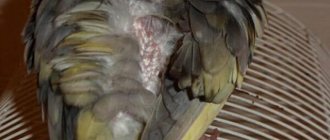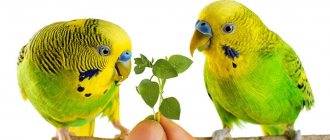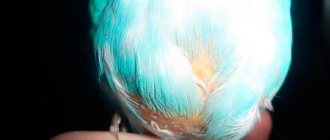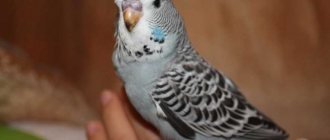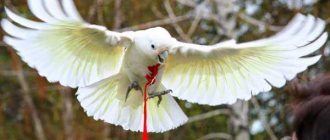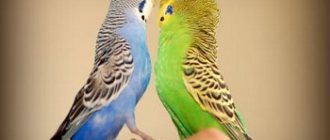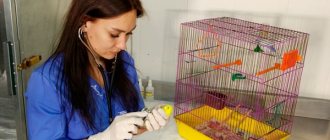Most poultry keepers are faced with the problem of feathers falling out in budgerigars and other species of parrots. This is a warning sign. A bald parrot can suffer from various diseases and experience severe stress. Therefore, it is necessary to understand why a parrot’s feathers fall out, what it signals, and how to correct the situation.
Why do parrots go bald?
The cause of feather loss in parrots may be hidden in an infectious disease, which only a veterinarian can diagnose. You should also know that natural molting in birds occurs no more than 1-2 times a year, and the behavior does not change much. In some breeds of parrots, molting occurs constantly, but gradually, so you will not notice any bare areas on its body. If your pet begins to move a little, constantly itches or pulls out its feathers, then you urgently need to look for the reasons for this behavior.
How to care for a parrot
Careful care and attention from the owners will help pet parrots to quietly endure the beginning of molting. Considering that during this delicate period, the immunity of feathered pets is significantly reduced, it is necessary to take a number of measures that will protect them from aggressive environmental influences and disease. Such preventive measures include:
- proper balanced nutrition, which will include a high content of beneficial vitamins and minerals;
- organization of walking - free flight around the apartment;
- water procedures;
- control of temperature and humidity in the room where the poultry is kept.
Nutrition during the molting period
During molting, the parrot needs to be fed better, since colossal reserves are spent on the growth of new plumage, and restoring their balance in the body is vital.
| Foods that must be included in the diet of a budgerigar are mandatory. | |||||
| Cereals; Seeds; Nuts; Sesame; | Fruits and berries, dried fruits from them | Vegetables | Greenery | Fermented milk feed | Animal feed |
| Canary seed; Meadow grass seeds; Bran, Special grain premixes “for shedding”. | Apples; Pears; Peaches; Bananas; Citrus; Melons; Cherries; Cherries; Apricots; Raspberries; Blackberry; Strawberry; Blueberry; Cowberry; Grape; Currant. | Carrot; Pumpkin; Zucchini; Cabbage; Cucumbers; Patissons. | Sprouted wheat and oats; Spinach; Dandelion; Plantain; Nettle; Carrot and beet tops; Celery; Chickweed; woodlouse; Shepherd's Purse; Tree branches. | Skimmed milk; Low-fat cottage cheese. | Mealworms; Bloodworm; Drosophila; Grasshoppers; May beetles; Eggs of chickens and quails. |
Vitamins and minerals
During the period of plumage change, the parrot's diet should contain the following minerals:
- meat and bone meal;
- calcium glycerophosphate;
- chalk;
- sand;
- sepia;
- feed sulfur;
- egg shells;
- crushed shells;
- crushed cuttlefish shell.
Preparations with a complex of vitamins are allowed to be given after the parrot is one year old.
Veterinarians recommend that during molting you pay attention to such vitamin mixtures as VitaCraft, VitaSol 8 in 1 UltraWhite, BifarMauser Trofen, BifarVinka, brewer's yeast with the addition of feed sulfur.
Parrot bathing
In addition to the fact that there should always be drinking water in the parrot’s cage, he needs to have “bath” days. Budgerigars love to splash around in the water, and during the molting period such procedures are especially recommended, since bathing helps to quickly get rid of old feathers, relieve itching, and improve their mood. Wild parrots bathe in the rain or look for morning dew on tree leaves to “wash themselves.”
To bathe your pet budgie, you can simply turn on the tap and let your pet out of the cage for a walk under such a “shower”. You can use a small container the size of a soup plate, pour water at room temperature into it, and place the container in the bird’s cage. Sometimes there are individuals with a special disposition who do not really like the prospect of being a little “damaged.” They can simply be sprayed with water from a water gun or spray bottle.
Air humidity
As you know, the birthplace of budgerigars is tropical and equatorial regions with high humidity. Therefore, when breeding these birds at home, they need to recreate conditions as close to natural as possible.
The most favorable temperature range is +20C-+25C.
But the most important thing is to maintain humidity in the apartment - it should be more than 60%. With these parameters, the parrot will feel comfortable, and the molting period will pass quickly and painlessly.
Stress or fear
This may also be the reason why parrots go bald. Such birds are quite shy and the slightest stressful situations can seriously affect their body. Loss of plumage is considered one of the manifestations of stress. This happens when there is a change of owner, sudden noises, or constant quarrels in the house. At the same time, the parrot becomes bald under the tail, in the tail part or in the small covert feathers; usually the feathers are lost in tufts, but when the bird calms down, the plumage will return to normal. Shock shedding may also be related to why your parrot is losing feathers on its head, neck, or other parts of its body.
Main reasons
Plumage problems in birds can arise for various reasons. It is important to identify the source of the malaise in order to properly provide assistance. When understanding why a parrot's feathers fall out, it is necessary to identify several factors that lead to situations in which the parrot goes bald.
Ecology
A budgerigar may lose its plumage due to changes in climate or living conditions. If your cockatiel lives in a cramped cage, this may affect his appearance. Due to lack of space, the bird will begin to rub against the bars of its home, losing its plumage.
Insufficient air humidification leads to the same consequences. The risk of baldness especially increases in those whose cells are located close to heating devices. A parrot will lose feathers under its wings and in other areas if proper hygiene is not followed. Not only does the bird need regular washing, but so does its cage. It is necessary to carefully care for all elements of your pet’s home and keep them clean.
Tight cage.
Dry air.
Cockatiels will lose their feathers when exposed to strong, unpleasant odors, including hairspray, tobacco, and others. Such aromas not only cause poisoning, but also provoke problems with plumage.
A parrot goes bald if the lighting in the room is not chosen correctly. An insufficient amount of light leads to a deterioration in the pet’s well-being. Flickering lights can cause stress and nervous disorders. If your pet constantly scratches itself with its beak until bald spots appear, this is an alarming signal.
The parrot is losing its tail and other parts of its body due to an allergic reaction that can occur to new foods, fillers, etc.
Psychological factor
When understanding why a parrot's feathers fall out, one should not exclude psychological reasons. Often, with the help of its beak and using its paws, the pet begins to actively pluck itself. This is his reaction to irritating factors. These include boredom and feelings of loneliness. The following situations can also provoke such a psychological reaction:
- Severe stress or fear;
- Lack of entertainment, including various toys;
- Birds are sensitive to the mood of their owners. Therefore, any problems and tension in the family are difficult to bear;
- Change of place of residence or owner;
- Constant sharp, noisy sounds. Birds often become stressed during repairs;
- The arrival of a child or a new pet. Some people pluck their feathers out of jealousy.
If a cockatiel's feathers fall out due to a psychological factor, it means that he is simply trying to attract the owner's attention to his condition, and therefore causes damage to himself. It is important to notice such a problem in time and correct it.
Avitaminosis
The parrot's head is going bald due to vitamin deficiency. It is this part of the body that suffers most from a lack of vitamins. There is less feathering on the head. This indicates that wavy pets need vitamins B and A.
A monotonous diet also causes loss of plumage. Your pet should eat a varied diet. His diet should contain foods rich in vitamins, including greens, carrots, apples, etc.
Vitamin deficiency leads not only to the loss of the previous appearance, but also to a general deterioration in health. Metabolic processes may be disrupted, and bone condition will worsen. Therefore, it is important to establish nutrition and constantly monitor your pet’s diet.
Shedding
When figuring out why your pet's feathers fall out, it is worth remembering that natural molting exists. This is a normal process that all birds go through. Shedding may be juvenile. Birds encounter it at a young age, when they are from 1.5 to 3 months old. The parrot's feathers fall out under its wings and in other places. A similar molt takes place after a few months. Many birds have a hard time surviving the juvenile period. They may change their behavior and become more aggressive, but this is the norm.
When understanding why a budgerigar's feathers fall out, it is worth noting that molting is not only primary, but also periodic. This usually occurs after the breeding season. Such molting happens a couple of times a year.
Your pet's mood may change slightly during this time. But then it quickly recovers and acquires its usual beautiful plumage.
Parasites and fungi
There are no feathers under the wings and in other areas of the body due to harmful parasites. The most common are fungal spores and scabies mites. Severe, incessant itching and pain lead to feathers flying throughout the house. The pet scratches the affected areas until they bleed. As a result, there are noticeably fewer feathers on his body.
Down feather eaters are small mites for which bird plumage has become the main delicacy. This is what these parasites feed on. It is necessary to get rid of them urgently. If treatment is neglected, as a result, the beautiful bird may remain disabled. It is important to recognize the disease in time and begin treatment. The following signs indicate a tick infestation:
- The feathers on the body have small holes;
- Inside the edges you can see a mass of dark color;
- On the abdomen and other areas, the cover became heterogeneous and disheveled;
- Signs of peeling appeared on the body;
- The skin looks inflamed, there are wounds under the wing and in other areas;
- The pet is constantly itching, in a bad mood, aggressive and irritated.
These signs should alert the owner and become a reason to contact a specialist.
Infections
When figuring out why your pet’s plumage has worsened, you shouldn’t forget about infections. Birds are susceptible to various diseases, including fungi and mites, which have already been mentioned.
It is worth noting a dangerous condition, better known as French molt in budgies. The disease is severe, and the nature of its development is not completely clear. The feathers on the body fall off mostly large ones. This molting affects mainly young individuals. The disease is characterized by a high probability that the pet will stop flying.
This condition can be caused by excess vitamin A or protein, heredity, or infections acquired at an early age.
Hormonal disbalance
Problems in hormonal levels lead to problems why parrots have thinning plumage. An imbalance of hormones worsens the general condition of the pet. It is worth remembering that a diet rich in protein and sprouted grains increases the release of sex hormones. The body begins to intensively prepare for reproduction, and if it does not occur, the bird has to part with some feathers. Restoring hormonal levels leads to an improvement in the plumage situation
Lack of vitamins and microelements
A common cause of shedding in parrots. Vitamins and minerals have a serious impact on the plumage, growth of claws and even the general condition of the parrot's body.
Birds with an unbalanced and improper diet often suffer from vitamin deficiency. At the same time, the daily menu includes several types of grains, but lacks the greens, fruits and vegetables that they need so much. In this case, the parrot becomes bald on the head, chest, neck, and tail. For treatment, it is necessary to purchase special vitamin complexes from veterinary pharmacies and balance the parrot’s diet.
Pregnancy and condylomas
Condylomas are an alarming signal for pregnant women. HPV in the body of the expectant mother does not have a harmful effect on the fetus, but such a lady must be under the supervision of the attending physician at all times. You can resort to removing growths only at the 28th week of pregnancy, not earlier. If the formations have settled on the genitals, then there is a high probability that the baby will acquire HPV while passing through the birth canal. If the infection is not treated, then the unpleasant moments associated with thrush increase in pregnant women. The best option is a thorough examination before pregnancy for HPV and, if it is detected, mandatory and complete treatment.
Fungal and tick-borne diseases
Fungi and mites that can get on your pet’s skin easily take root and multiply there, causing serious harm to his body. The parrot loses feathers on its chest, head, neck, and almost any part of the body where a mite or fungus lives. At the same time, the bird experiences severe itching, lethargy, and constantly scratches against the cage.
To distinguish this lesion from any other, examine the shaft of the fallen feather; mites may leave small holes in it, and the tip of the feather may contain traces of blood. When examining your pet's skin, you may find signs of peeling, wounds, or plaques.
With these diseases, it is also necessary to examine the wax, paws and beak; they may also have wounds and peeling.
These diseases will never go away on their own and can lead to the death of the bird, so if you notice the above signs of damage, contact your veterinarian immediately. Ointments are usually prescribed, and treatment can last more than a month.
Treatment and prevention
If your budgerigar's feathers are falling out, you need to carefully examine it to determine the cause of this phenomenon. If the feathers fall out evenly and there are no bald spots on the body, then it is time for seasonal molting, and human intervention is not required. If the bird has become lethargic, has lost its appetite, and the feathers fall out in tufts, leaving bald patches, you should consult a veterinarian to determine the cause of the baldness.
Treatment for your pet depends on the diagnosis. Sometimes it is enough to normalize the living conditions and diet, pay more attention to the pet, or place a partner of the same species with it. In other cases, treatment with hormonal, antimicrobial, antiparasitic and other medications may be required.
To prevent loss of plumage, you must comply with all requirements for keeping and feeding the bird and properly care for it. The cage should be spacious so that the parrot can move freely around it and not touch the walls with its wings and tail. It is located in a room with good ventilation, away from heating devices and noise sources. The diet should be varied and include vitamin and mineral supplements. The owner should spend as much time as possible interacting and playing with the bird; To keep her from getting bored, toys are placed in the cage. The parrot's home is regularly washed and disinfected to prevent the proliferation of fungi and parasites.
French molt in parrots
It is considered a fairly serious and severe disease, which usually manifests itself at an early age. Signs of French molt in parrots: complete loss of flight and tail feathers before leaving the nest or immediately after.
Birds become completely naked and cannot fly; they move using their beaks or jumping. The real causes of this disease cannot be determined, but some veterinarians suggest that it develops due to insufficient protein intake. If you feed and care for the chick properly, the plumage can be restored.
It is not recommended to use parrots who suffered from this pathology in childhood for further reproduction.
Hormones
Hormones affect not only our lives, but also the life of a parrot no less.
As you know, there are a lot of hormones known, and they are produced by endocrine glands. We will be more interested in the pituitary gland and the thyroid gland (thyroid gland).
When the level of hormones drops towards deficiency or excess, this immediately affects the quality and growth of feathers.
If the problem is in the pituitary gland, then it is unlikely that anything can be done, since there is simply no treatment, but in the case of the thyroid gland, everything can be solved with simple treatment.
A parrot's feathers are falling out - what to do?
- Examine the parrot. There should be no traces of droppings under the tail, the eyes should be clean, and the beak should be smooth.
- Observe the behavior of the bird. Decreased appetite, activity, trembling are reasons to be wary.
- If you suspect the presence of parasites, disinfect the cage and all contents and contact a veterinarian.
- Balance your diet.
- If the parrot has experienced stress, then you can add sedatives to the food.
- Ensure the required level of humidity in the room, as too dry air leads to discomfort, the bird begins to itch and pull out feathers. Place a bathtub for bathing.
It is recommended to conduct regular preventive examinations to prevent the occurrence of serious diseases in the future.
Budgerigar pregnancy
A bald bum and bald belly in a female budgerigar may be signs of pregnancy.
How can you be sure that your bird is healthy, even though her bottom is balding and that she will soon lay an egg? Let's check for the following signs of wavy pregnancy:
- The cloaca area is significantly enlarged.
- The number of litters of a feathered pet increases sharply.
- The female parrot's tail twitches up and down, as if biting a fishing rod.
- The back of the wavy friend is going bald.
- The bird's belly increases significantly.
- The belly becomes bald, which the female regularly combs with her paw.
- The bird's behavior changes. She becomes clumsy, sleeps more, eats everything she gets into her beak. It could be paper, a piece of leather or a stone.
- The female establishes the nest, collecting a feeder, toys, and brushwood in one place.
There is no need to solve this problem, it will resolve itself, and you can soon rejoice at the birth of chicks.
Bird care
Now the parrot began to receive the necessary vitamins, and useful products began to be applied to the skin. Since the bird can be considered naked, its skin needed good care. They started applying Vaseline and coconut oil to the parrot to remove the dryness. The bird no longer flies, but people do not let it be sad, entertaining it in every possible way.
Sometimes Blondie gets cold, then she is given a warm blanket that is perfect for her size. Over the course of three years, the bird itself and its owners have become accustomed to the absence of feathers. No one focuses on the appearance of the parrot, because it is already valued. Isabella's family believes that their bird is a true warrior and that their pets should be loved no matter what.
Found a violation? Report content
Psychological state of the bird
Baldness can also occur if the parrot is psychologically unstable. Birds are impressionable pets, and feather loss can cause:
- moving, change of scenery;
- change of owner;
- repairs and loud noise;
- the presence of other pets or children;
- fright;
- family troubles with the owner - parrots feel emotional stress;
- loneliness and boredom.
With any psychological disorder, a parrot plucks its feathers heavily, sometimes to attract attention, and sometimes simply out of boredom. Even healthy parrots can pluck feathers, but the main feature here is strong plucking. Providing him with peace and attention will help ease your pet's condition. With proper care, the bird will stop moulting within 5-7 days.
Habitat and lifestyle
Budgerigars are native to Australia. The birds are native to the southwest and east coasts and are found on nearby large and small islands. Birds choose steppe and semi-steppe zones for themselves. In the north of the mainland, where forests are very dense, wavy plants are rare.
Parrots gather in numerous flocks. Each of them can number several dozen or even hundreds of birds. They often change their location to find areas rich in food and water. It is not difficult for budgerigars to overcome huge distances, as they move very quickly. Their flight speed can reach 100-120 km/h.
In recent decades, the population of wild budgerigars on the Australian continent has declined sharply. People who interfere with nature and destroy it are to blame for this.
Treating your favorite birds
What to do when a parrot loses its plumage a lot and turns into a pitiful naked carcass? Before deciding to have pet birds, the future owner needs to study the rules for keeping parrots and ensure they have a full-fledged existence. And at the first signs of illness, immediately contact a veterinarian.
Only an experienced doctor can prescribe adequate and competent treatment for parrots. The advice of experts, not the arrogance of the owner, helps to put the bird in order!
Rules for keeping parrots
The subtleties of caring for friendly and funny winged pets depend on the breed of the parrot, the size of the bird and the characteristics of its habitat in natural conditions. But there are a number of general principles, following which the owner will ensure a comfortable and healthy existence for the pet. Before buying a parrot, prepare for its arrival:
- Spacious cage. For active birds, the dimensions of the home should start from 40x25x30 cm (this is the minimum). The larger the bird, the larger the house will be - the bird needs to freely flutter around the house without touching the bars.
- Feeder, bath and drinking bowl. It is advisable to purchase a couple of containers for food - for soft and grain foods. The best material is porcelain or plastic. You will need a bath in hot weather - after each bath, change the water and clean the container.
- Chalk for birds, various sticks, sand. Choose different perches, preferably from hard wood species (birch, oak, maple). The best diameter is 1.5-2 cm. Chalk supplies the bird with calcium and helps to sharpen the beak. And the sand is poured into a tray - it is necessary for good digestion (sand can be poured into a separate feeder).
- Toys (noisy, ringing, be sure to buy a mirror). A mirror will be needed if the pet plans to live separately.
- The menu should include: grain mixture, branches of deciduous trees (linden, aspen, hazel, rowan). Vegetables, curd products, fruits, and chicken eggs. Herbs (parsley, dill, sorrel, lettuce, dandelion stems). In winter, pamper your pet with sprouted grain (give the sprouts in portions and immediately remove the leftovers).
Let's go get the parrot. When purchasing a future pet, carefully inspect the bird. A healthy bird, cheerful and curious, with clean plumage without a hint of a bald spot. The beak is smooth without defects. The eyes are not puffy, clear. A bird in good health does not cough or sneeze. It is better to purchase young chicks - they will quickly get used to new living conditions.
We place the cage. Install the pet's home away from drafts and heating devices, preferably at the level of the owner's head.
It is forbidden! Place the cage in the kitchen, install it on household appliances (computer, oven, TV, microwave, refrigerator).
The parrot's home should be well illuminated by the sun's rays, but do not overuse the light - cover part of the house with a cloth so that the parrot can hide. For birds, the optimal air temperature is +20-25⁰ C. When choosing a cage size, be guided by the breed of bird:
Causes of baldness
According to breeders, the loss of feathers on a bird’s body is a common phenomenon. The parrot is a capricious and sensitive creature. The body of talkative birds reacts sharply to any changes, both physically and emotionally.
What causes baldness? Breeders divide the reasons for the loss of feathers of their beloved pets into three groups.
Medical problems
There are no sweat glands on the skin of parrots; the skin easily moves in different directions. What does predisposition to various diseases of the subcutaneous tissue and epidermis mean? Budgerigars, lovebirds and masked parrots are especially susceptible to skin pathologies.
Skin diseases of talkative pets are difficult to cure. Birds itch a lot and tend to peck at itchy areas, which causes chronic irritation.
We should not forget that feather loss in parrots also has natural causes (molting). Owners need to be able to distinguish when a bird is molting and when it is sick. Signs of disease in parrots appear instantly, on the first day, and the symptoms progress as follows:
- Loose stools begin.
- The parrot refuses to eat.
- Areas of flaking, similar to dandruff, can be seen on the skin.
- The fallen feathers are dark, and there are bloody marks on the bases.
- The beautiful plumage on the chest and back becomes dull and brittle. The bird looks disheveled.
Natural molting does not leave such marks. All skin diseases that lead to feather loss differ in etiology and symptoms. Ornithologists include the following diseases as common ailments:
Problems with hormonal levels. Hormones are very important for bird health. In a parrot, hormonal production is carried out by two organs: the pituitary gland and the thyroid gland. As soon as a violation occurs in one of them, the growth of feathers slows down and they begin to fall out.
In addition to baldness, hormonal imbalances occur with a general darkening of the plumage and a decrease in weight in the bird. In this case, the veterinarian is only able to normalize the functioning of the thyroid gland by prescribing therapeutic measures to the bird. But it is no longer possible to cope with pituitary gland disorders.
French molt. A serious disease that affects young parrots. After 3.5-4 weeks of life, birds begin to lose their flight and tail feathers profusely (on the wings and from the tail).
The bird that was able to survive can no longer fly for the rest of its life (new feathers do not grow). She moves in short dashes or leaps. Such parrots are called “runners”.
Veterinarians consider the following factors to be the causes of incurable disease:
- When eggs are laid early.
- Past infectious diseases.
- Using sick birds for breeding.
- Unfavorable conditions for the reproduction of birds.
- Stress that develops in birds due to long, exhausting journeys.
- Numerous laying of eggs and hatching of offspring more than twice per season.
- Feeding food containing large amounts of vitamin A and a minimal percentage of vitamins K and E.
If your parrot gets sick, surround the bird with care and create optimal living conditions for it. The owner needs to pay special attention to the diet and breeding of sick parrots.
Fungal and tick-borne infections. Extremely dangerous diseases in feathered pets. Mites and fungal spores, ending up on the skin of parrots, provoke excessive loss of feathers and peeling of the epidermis. Wounds and growths appear on the surface of the skin. Symptoms of the pathology:
- Drying and cracking of birds' feet.
- The skin of the body becomes inflamed and red spots are observed on it.
- The parrot becomes unkempt, disheveled and sick.
- Peeling begins in the beak area, on the head and cere.
- Fallen feathers look shaggy, with crooked, unkempt tips.
- Feather loss occurs unevenly (foci of baldness are located on the butt, on the back or on the neck).
Parasitic mites gnaw holes in the delicate skin of birds at the base of the feathers. Because of this, the feathers that fall out have bloody bases. If you notice feathers with blood, immediately go to the veterinarian - the owner will not be able to overcome dangerous diseases on his own.
To combat ticks, doctors often prescribe Aversectin ointment - the bird will be treated with this product for 3-4 months. The bird's cage with all its accessories will also have to be treated. It is better to use Neostamazan (one ampoule for ½ liter of water). After disinfection, the cage and toys are doused with boiling water and dried.
Parasitic, fungal, infectious diseases
Very often, budgies lose their feathers due to infection with external parasites. If a parrot's body is parasitized by mites, the bird experiences severe itching and anxiety. In addition to fallen feathers, scratches, sores, and wounds appear on the body. The skin is peeling. With severe infection, acute inflammation can develop in various structures of the dermis. Infection with down feather eaters and scabies mites leads to deterioration of the plumage and provokes severe feather loss.
Sign of tick infestation
You can understand that a parrot is infected with a tick after a visual inspection of the pet or by performing a simple test. Line the bottom of the cage with white paper or a light-colored cloth. If you see small dark dots, be sure that your parrot is infected with a mite.
